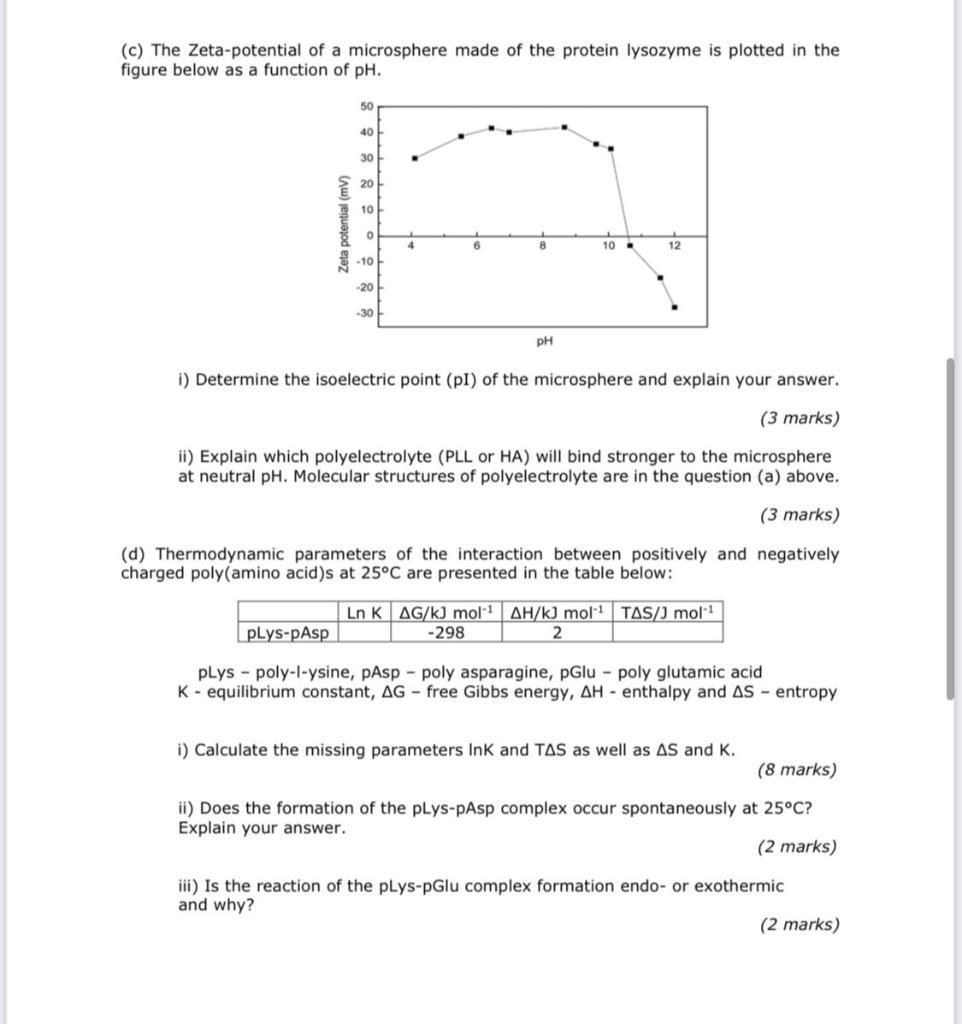

(a) Calculate the mass (in mg) of poly-I-lysine (PLL) needed to form a complex with 10 mg of hyaluronic acid (HA). The stoichiometric molar ratio of charged groups in the complex is 1:1. ( 6 marks) (b) The mechanical behaviour of two polyallylamine hydrochloride/carrageenan (PAH/carr) multilayer films was studied using the colloidal probe technique. Two different multilayer films have been fabricated: (PAH/1-carr) 30 and (PAH/-carr) so 30 and force-deformation curves are shown below. (i) In which film is the higher force required to produce the same extent of deformation of the film? Explain your answer. (3 marks) (ii) Explain which of the two films in the figure is expected to have a higher value of Young's modulus. (3 marks) (c) The Zeta-potential of a microsphere made of the protein lysozyme is plotted in the figure below as a function of pH. i) Determine the isoelectric point (pI) of the microsphere and explain your answer. ( 3 marks) ii) Explain which polyelectrolyte (PLL or HA) will bind stronger to the microsphere at neutral pH. Molecular structures of polyelectrolyte are in the question (a) above. ( 3 marks) (d) Thermodynamic parameters of the interaction between positively and negatively charged poly(amino acid)s at 25C are presented in the table below: pLys - poly-l-ysine, pAsp - poly asparagine, pGlu - poly glutamic acid K - equilibrium constant, G - free Gibbs energy, H - enthalpy and S - entropy i) Calculate the missing parameters lnK and TS as well as S and K. (8 marks) ii) Does the formation of the plys-pAsp complex occur spontaneously at 25C ? Explain your answer. (2 marks) iii) Is the reaction of the pLys-pGlu complex formation endo- or exothermic and why? ( 2 marks) (a) Calculate the mass (in mg) of poly-I-lysine (PLL) needed to form a complex with 10 mg of hyaluronic acid (HA). The stoichiometric molar ratio of charged groups in the complex is 1:1. ( 6 marks) (b) The mechanical behaviour of two polyallylamine hydrochloride/carrageenan (PAH/carr) multilayer films was studied using the colloidal probe technique. Two different multilayer films have been fabricated: (PAH/1-carr) 30 and (PAH/-carr) so 30 and force-deformation curves are shown below. (i) In which film is the higher force required to produce the same extent of deformation of the film? Explain your answer. (3 marks) (ii) Explain which of the two films in the figure is expected to have a higher value of Young's modulus. (3 marks) (c) The Zeta-potential of a microsphere made of the protein lysozyme is plotted in the figure below as a function of pH. i) Determine the isoelectric point (pI) of the microsphere and explain your answer. ( 3 marks) ii) Explain which polyelectrolyte (PLL or HA) will bind stronger to the microsphere at neutral pH. Molecular structures of polyelectrolyte are in the question (a) above. ( 3 marks) (d) Thermodynamic parameters of the interaction between positively and negatively charged poly(amino acid)s at 25C are presented in the table below: pLys - poly-l-ysine, pAsp - poly asparagine, pGlu - poly glutamic acid K - equilibrium constant, G - free Gibbs energy, H - enthalpy and S - entropy i) Calculate the missing parameters lnK and TS as well as S and K. (8 marks) ii) Does the formation of the plys-pAsp complex occur spontaneously at 25C ? Explain your answer. (2 marks) iii) Is the reaction of the pLys-pGlu complex formation endo- or exothermic and why? ( 2 marks)








